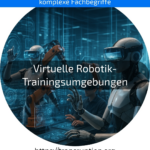The term "virtual robotics training environments" is primarily used in the fields of robotics, virtual and augmented reality as well as Industry and Factory 4.0, where robots are no longer trained and tested exclusively in the real world, but on the computer.
Instead of laboriously programming a real robot in a workshop, the control system can first be tested in a virtual environment. This saves time and money and reduces the risk of errors or damage. The software simulates how the robot behaves when it grips a specific component or moves through a production line, for example.
An illustrative example: A new robotic arm is to be used in a car factory. Before the real robot is delivered, the manufacturer creates a virtual robotics training environment. In this simulation, engineers programme and test all movements virtually. As soon as everything runs optimally, the settings are transferred to the real robot.
Virtual robotics training environments therefore allow automation to be implemented faster, more cost-effectively and more safely. Companies benefit from more flexible processes and lower start-up costs without having to compromise on safety.






